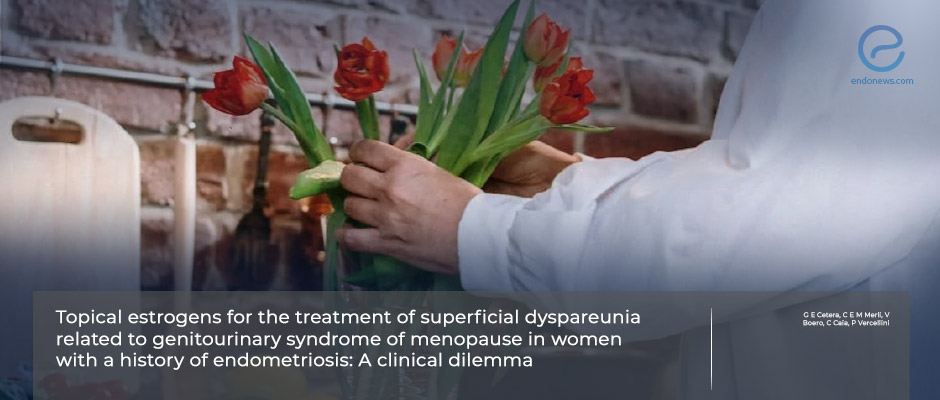Treatment of superficial dyspareunia using topical estrogens in postmenopausal women with a history of endometriosis
Sep 15, 2023
Vulvar estrogen application is more efficacious for the treatment of superficial dyspareunia in endometriosis patients during the postmenopausal period.
Key Points
Highlights:
- Topical estrogen application rather than systemic hormonal therapy for superficial dyspareunia for genitourinary syndrome of menopause may be more appropriate in women with a history of endometriosis.
Importance:
- Patients using topical estrogen for superficial dyspareunia during menopause should be counseled regarding the need for further studies on the safety and effects on endometriotic lesions.
What’s done here?
- This review article assesses the suitability of topical estrogen therapy for vulvovaginal atrophy-associated superficial dyspareunia in women with a history of endometriosis.
- Genitourinary syndrome of menopause during the postmenopausal period due to estrogen withdrawal negatively affects women's quality of life.
- Vulvovaginal atrophy that does not resolve spontaneously and progresses can be managed with hormonal or non-hormonal treatments.
- In selected populations such as those with a history of endometriosis, local hormonal treatments are preferred to avoid systemic absorption and possible side effects such as reactivation of endometriotic foci and malignant transformation.
Key results:
- Topical low-dose estrogens have been found to be superior to systemic hormonal therapies for superficial dyspareunia which is unresponsive to non-hormonal treatments such as moisturizers and lubricants.
- Topical estrogen therapy applied to the vulvar vestibule instead of the vagina has been detected to be more effective.
- Vulvar estrogen application does not have any negative effect on endometriotic lesions as it reduces the possibility of uterine absorption compared to systemic therapy.
- There is no significant difference among different topical estrogenic compounds and routes of administration regarding their efficacy and adverse effects.
Strengths:
- This is the first study to analyze the appropriateness of topical estrogens in postmenopausal patients with a history of endometriosis.
Lay Summary
Genitourinary syndrome of menopause is defined as a collection of symptoms and signs caused by hypoestrogenic changes to the labia majora/minora, clitoris, vestibule/introitus, vagina, urethra, and bladder that occur in menopausal patients. Sexual dysfunction and superficial dyspareunia can be experienced by postmenopausal women resulting in decreased quality of life. Hormonal or non-hormonal treatments (lubricants/moisturizers) may be prescribed to manage vulvovaginal atrophy-associated superficial dyspareunia.
It should be known that there are some special populations, such as women with a history of endometriosis: endometriotic foci should not be reactivated and malignant transformation should not be caused when planning treatment.
Cetera et al., from Italy, published a review article titled “Topical estrogens for the treatment of superficial dyspareunia related to genitourinary syndrome of menopause in women with a history of endometriosis: A clinical dilemma” in the journal named European Journal of Obstetrics and Gynecology.
The authors questioned the efficacy and safety of topical estrogen therapy in the treatment of genitourinary syndrome and superficial dyspareunia in postmenopausal women with a history of endometriosis. Because reactivation of endometriotic foci or malignant transformation is possible by using exogenous estrogen.
Topical low-dose estrogens applied to the vulvar vestibule instead of the vagina have been found to be superior to systemic hormonal therapies for superficial dyspareunia which is unresponsive to non-hormonal treatments. In addition, there is no significant difference among different topical estrogenic compounds and routes of administration regarding their efficacy and adverse effects.
“Minimal systemic absorption of topical estrogens carries a low probability of reactivation and malignant transformation of the disease in cases of all types of endometriosis including superficial peritoneal and ovarian endometriosis, deep infiltrating endometriosis.” the authors added.
Research Source: https://pubmed.ncbi.nlm.nih.gov/37421742/
endometriosis genitourinary syndrome of menopause dyspareunia sexual dysfunction hormonal therapy topical estrogens

